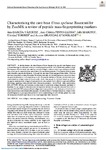Mostrar o rexistro simple do ítem
Characterising the Cave Bear Ursus Spelaeus Rosenmüller by Zooms: A Review of Peptide Mass Fingerprinting Markers
| dc.contributor.author | García-Vázquez, Ana | |
| dc.contributor.author | Pinto-Llona, Ana C. | |
| dc.contributor.author | Maroto, Julià | |
| dc.contributor.author | Torres, Trinidad | |
| dc.contributor.author | Grandal-d'Anglade, Aurora | |
| dc.date.accessioned | 2024-01-03T11:31:38Z | |
| dc.date.available | 2024-01-03T11:31:38Z | |
| dc.date.issued | 2023-02-27 | |
| dc.identifier.citation | GARCÍA-VÁZQUEZ A, PINTO-LLONA AC, MAROTO J, TORRES T, GRANDAL-D’ANGLADE A. Characterising the cave bear Ursus spelaeus Rosenmüller by ZooMS: a review of peptide mass fingerprinting markers. Earth and Environmental Science Transactions of the Royal Society of Edinburgh. 2023;114(1-2):83-93. doi:10.1017/S1755691023000038 | es_ES |
| dc.identifier.issn | 1755-6929 | |
| dc.identifier.uri | http://hdl.handle.net/2183/34736 | |
| dc.description.abstract | [Abstract] In the last decade, the identification of bone fragments by peptide mass fingerprinting or zooarchaeology by mass spectrometry is developing as a powerful tool in Quaternary palaeontology. The sequence of amino acids that make up the bone collagen molecule shows slight variations between taxa, which can be studied by mass spectrometry for taxonomic purposes. This requires reference databases that allow peptide identification. Although the cave bear (Ursus spelaeus Rosenmüller, 1794) is a common component in many European Pleistocene cave sites, no peptide fingerprint taxonomic study has paid special attention to this species up to now. For peptide markers in Ursidae, the most recent proposal is based on collagen obtained from a modern brown bear sample. In this work we attempt to cover this gap by studying bone collagen of cave and brown bear samples from different origins and different chronology, applying matrix-assisted laser desorption/ionisation time-of-flight mass spectrometry (MALDI TOF). We also performed an in-silico study of ursid bone collagen sequences published in databases. In our results we detected some discrepancies between the peptides obtained from both in silico and MALDI TOF analysis of fossil collagen and those published in the literature, in which we conclude that there are some misidentified peptides. The identification of skeletal remains by means of their peptide fingerprint is proving to be a powerful tool in palaeontology, which will bear greater fruit once the limitations of a technique that is in its initial stages have been overcome. | es_ES |
| dc.description.sponsorship | This study was carried out with the financial support of the project ED431B 2021/17 of the Autonomous Government of Galicia (Spain) awarded to AGD | es_ES |
| dc.description.sponsorship | Galicia. Xunta; ED431B 2021/17 | es_ES |
| dc.language.iso | eng | es_ES |
| dc.publisher | Cambridge University Press | es_ES |
| dc.relation.uri | https://doi.org/10.1017/S1755691023000038 | es_ES |
| dc.rights | Atribución-NoComercial-CompartirIgual 4.0 Internacional | es_ES |
| dc.rights.uri | http://creativecommons.org/licenses/by-nc-sa/4.0/ | * |
| dc.subject | Bone collagen | es_ES |
| dc.subject | Molecular palaeontology | es_ES |
| dc.subject | Pleistocene | es_ES |
| dc.subject | Ursidae | es_ES |
| dc.title | Characterising the Cave Bear Ursus Spelaeus Rosenmüller by Zooms: A Review of Peptide Mass Fingerprinting Markers | es_ES |
| dc.type | info:eu-repo/semantics/article | es_ES |
| dc.rights.access | info:eu-repo/semantics/openAccess | es_ES |
| UDC.journalTitle | Earth and Environmental Science Transactions of The Royal Society of Edinburgh | es_ES |
| UDC.volume | 114 (2023) | es_ES |
| UDC.issue | Special Issue 1-2: 3rd palaeontological virtual congress | es_ES |
| UDC.startPage | 83 | es_ES |
| UDC.endPage | 93 | es_ES |
| dc.identifier.doi | 10.1017/S1755691023000038 | |
| UDC.conferenceTitle | Palaeontological Virtual Congress (3º) | es_ES |
Ficheiros no ítem
Este ítem aparece na(s) seguinte(s) colección(s)
-
IUX-CULXEO - Artigos [63]






